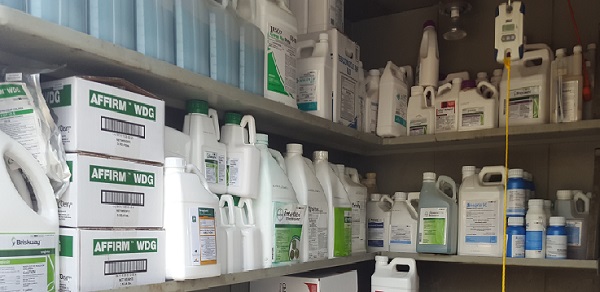Storage and handling of pesticides in their concentrated form poses the highest potential risk to groundwater or surface waters. For this reason, it is essential that facilities for storing and handling these products be properly sited, designed, constructed, and operated. In addition, storing large quantities of pesticides for long periods of time should be avoided. Adopting a “first in-first out” management system for pesticide purchase and storage helps to avoid a buildup of large quantities of chemicals.
At a minimum, Maryland regulations require that pesticide storage areas must meet requirements as described previously under Regulatory Considerations section. For more information on pesticide storage and handling in Maryland see the following:
- Pesticide Information Leaflet No. 39: Pesticide Storage and Security. 2012. University of Maryland.
- Chapter 8 “Transportation, Storage, and Security.” Maryland Pesticide Applicator Core Manual. pp. 124-135.
- Pesticide Information Leaflet No. 35: Synopsis of the Maryland Pesticide Applicators Law and Regulations. 2012. University of Maryland.
Best Management Practices
- Maintain an inventory of all pesticides used and the SDS for each chemical.
- Avoid purchasing large quantities of pesticides that require storage for greater than six months.
- Adopt the “first in–first out” principle, using the oldest products first to ensure that the product shelf life does not expire.
- Store, mix, and load pesticides away from sites that directly link to surface water or groundwater.
- Store pesticides in a lockable concrete or metal building that is separate from other buildings.
- Locate pesticide storage facilities away from other structures to allow fire department access.
- Storage facility floors should be impervious and sealed with a chemical-resistant paint.
- Floors should have a continuous sill to retain spilled materials and no drains, although a sump may be included.
- Sloped ramps should be provided at the entrance to allow the use of wheeled handcarts for moving material in and out of the storage area safely.
- Shelving should be made of sturdy plastic or reinforced metal.
- Metal shelving should be kept painted to avoid corrosion. Wood shelving should never be used, because it may absorb spilled pesticides.
- Automatic exhaust fans and an emergency wash area should be provided. Light and fan switches should be located outside the building, so that both can be turned on before staff enter the building and turned off after they leave the building.
- Avoid temperature extremes inside the pesticide storage facility.
- PPE should be easily accessible and stored outside the pesticide storage area.
- Do not transport pesticides in the passenger section of a vehicle.
- Never leave pesticides unattended during transport.
- Place a spill containment kit in the storage area, in the mix/load area, and on the spray rig.

Pesticide storage areas should be separate from storage areas for other chemicals. Photo credit: Joseph Roberts.
Next: Mixing/Washing Station

